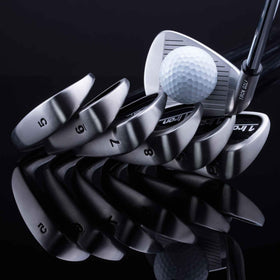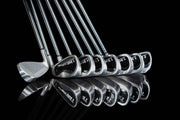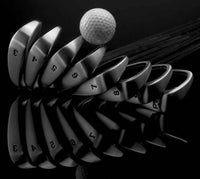Improve Your Iron Play with Single Length Irons
by David Lake
The dynamics of ball contact with an iron are the same whether playing conventional or Single Length irons. We have all been told to hit down on the ball, but what does this mean? Simply put, it means making contact with the ball just prior to reaching the lowest point in your swing arc. The lowest portion in your swing arc occurs directly in the center of a shoulder width stance (assuming that you do not sway to either side during your swing). By placing the golf ball in this spot you will make contact with the outside of the ball an instant before the sole of the clubhead touches the ground. This is in effect hitting down on the ball. Don’t be misled; “hitting down on the ball” does not mean attacking the ball with a steep swing plane and leaving a crater in the ground. This simply means that you are hitting the ball just prior to the lowest point in your swing arc and then leaving a small divot or a slight scar on the ground after ball contact. The advantages of hitting down on the ball are too numerous to mention, but here are a few of the major ones:
- Imparts more backspin to the ball which produces ideal trajectory and keeps the shot on line.
- Increases distance since the angle of attack ensures that you are using the designed loft angle of the clubface (scooping the ball effectively increases this loft angle).
- Allows you to consistently hit the ball from any kind of turf condition or lie.
Hitting down on the golf ball is important for all of the reasons mentioned above. However, the most overlooked and most important reason for learning to hit down on the ball is that it keeps you from doing just the opposite which is to scoop it. A scoop occurs when impact is made with the ball past the lowest point in the swing arc. The clubhead is actually moving in an upward arc at this point and lifting the ball into the air. Scooping the ball is a very common habit and is caused unconsciously by the idea that the ball needs to be “lifted” into the air (the fact that the ball is sitting up on the grass and is in essence teed up ½” to 1″ off the ground unconsciously reinforces this idea). This not only results in very little back-spin imparted to the golf ball resulting in poor accuracy, but since the clubhead impacts the ball past the lowest point of it’s arc the loft angle of the clubface is effectively increased causing a dramatic loss of distance. Another point is that when you scoop the ball your swing force is directed upwards rather than down the target line which greatly reduces the effective power in your shot.
You can learn to hit down on the ball by hitting shots at the practice range with the center of the ball lined up with a tee sticking in the ground. After hitting a shot the tick mark in the turf should be an inch or so to the left of the tee (R/H golfer). This indicates that you are making contact with the ball prior to ticking the turf. To achieve this consistently it is important to not look at the ball at address, but rather, pick out a spot an inch or so forward of the ball. It is important to understand that the spot you look at (as during a practice swing) is where the sole of the clubhead will make turf contact. Consequently, you want to be looking at a spot forward of the ball during your swing and just let the ball get in the way of the clubhead through impact. I personally learned to hit down on the ball by hitting shots off the base paths of a local baseball diamond. Believe me, if you hit a fat shot off a hard base path your ancestors will feel the shock.
Let me give you my own example. When I began playing golf, like most beginning golfers, I attempted to scoop the ball into the air on every iron shot. I did not understand loft angles or swing dynamics and thought that if I hit down on the ball I would only hit line drives at best. For about a year this scooping method worked fine. Then I played a course with bent grass fairways. If you have never played bent grass, it is like the name implies, the grass lays flat on its side, flat on the ground, and so does the ball. Since the normal ½” or so of grass under the ball was not present I hit practically every iron shot fat and those that I didn’t hit fat I bladed into the next county. I shot a 125 that day when I was used to shooting in the mid 90’s. Naturally, it didn’t take me long to decide to change my method of ball striking.
The changes in my game after learning to hit down on the ball? As an example: when I scooped the ball my PW distance was consistently 70 yards, and after becoming proficient at hitting down on the ball my PW distance jumped to a consistent 120 yards. My distance and accuracy increased tremendously with every iron in the bag with the ball virtually exploding off the clubface on every shot. Anyway, I played that same bent grass golf course a few months later and shot a 79.










